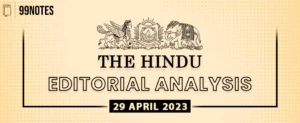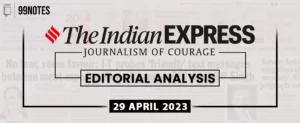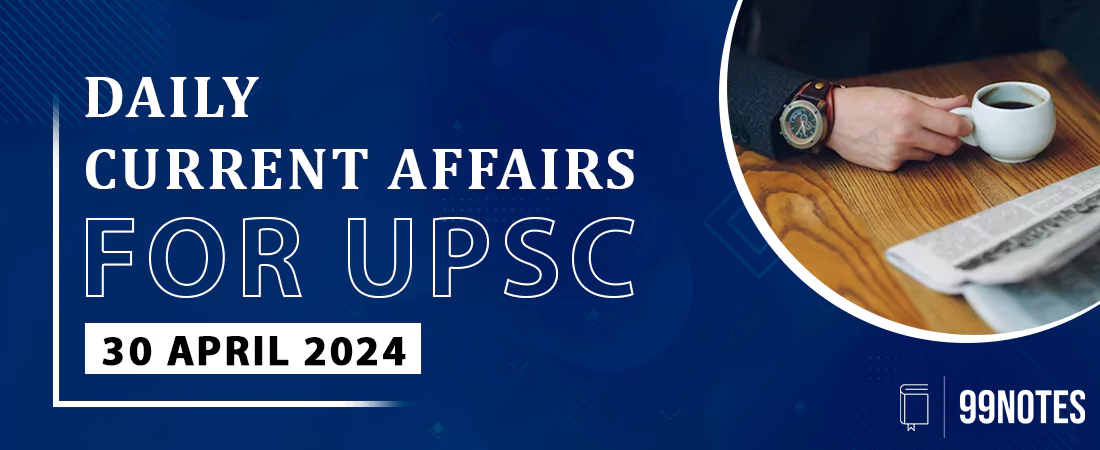30 April 2024 : Daily Current Affairs
Daily Current Affairs
30-April -2024- Top News of the Day
1. NCW says ‘no information’ on the political affiliation of its Chairperson, Members
| (Source – The Hindu, Section – News, Page – 4)
Topic: GS2 – Indian Polity – Statutory bodies UPSC candidates need awareness on NCW’s neutrality, transparency, and accountability concerning political affiliations for governance and ethics topics. |
| Context: |
|
Analysis of the news:
- The National Commission for Women (NCW) states it lacks information on political affiliations of Chairperson and Members.
- PIO response under RTI Act reveals NCW’s statutory setup by the Ministry of Women and Child Development.
- Government nominates NCW Chairperson and Members.
- PIO confirms no records on political participation or legality regarding such actions.
- Petitioner Raj Kapil witnessed an NCW Member attending BJP events, formerly serving in BJP’s national executive committee.
- NCW’s mandate includes evaluating women’s development progress under Union and State governments.
- Kapil argues NCW officials should maintain neutrality by not affiliating with political parties during their term.
- Lack of transparency raises concerns about accountability and potential bias in NCW decisions.
| More About National Commission for Women (NCW): |
| ● Establishment: The National Commission for Women (NCW) was established in 1992 under the provisions of the National Commission for Women Act, 1990.
● Mandate: The NCW is tasked with safeguarding and promoting the rights of women in India, ensuring their protection from discrimination and violence. ● Functions: It investigates and examines complaints related to women’s rights violations, conducts studies, and recommends legislative and policy measures for women’s empowerment. ● Awareness Programs: The NCW organises awareness campaigns, workshops, and seminars to raise awareness about gender issues and promote gender equality. ● Legal Advocacy: It provides legal aid and assistance to women facing discrimination or injustice, including cases of domestic violence, harassment, and dowry-related offences. ● Policy Advocacy: The NCW advocates for gender-sensitive policies and reforms at the national and state levels to address systemic issues affecting women’s rights. ● Research and Documentation: It conducts research, collects data, and publishes reports on various aspects of women’s issues to inform policymaking and advocacy efforts. ● Collaboration: The NCW collaborates with government agencies, civil society organisations, and international bodies to advance women’s rights and gender equality initiatives. Potential implications of political bias from statutory bodies: ● Undermining Objectivity: Political bias in statutory bodies can compromise their impartiality and objectivity in decision-making processes. ● Selective Enforcement: Political influence may lead to selective enforcement of laws and regulations, favouring certain groups or individuals aligned with the ruling party. ● Erosion of Public Trust: Perceived political bias erodes public trust in statutory bodies, undermining their legitimacy and credibility. ● Violation of Rights: Political interference may result in the violation of human rights, undermining the principles of democracy and rule of law. ● Impediment to Accountability: Political bias can impede accountability mechanisms, hindering transparency, and accountability in governance. ● Impact on Policy: Statutory bodies influenced by political bias may recommend or implement policies that serve partisan interests rather than the public good. ● Threat to Democracy: Political bias in statutory bodies poses a threat to democratic governance, as it undermines the principles of separation of powers and checks and balances. ● Need for Independence: Ensuring independence and autonomy of statutory bodies from political interference is essential to uphold their integrity and effectiveness in fulfilling their mandates. |
| PYQ: Which steps are required for constitutionalization of a Commission? Do you think imparting constitutionality to the National Commission for Women would ensure greater gender justice and empowerment in India? Give reasons. (250 words/15m) (UPSC CSE (M) GS-2 2020) |
| Practice Question: Discuss the significance of ensuring political neutrality in statutory bodies like the National Commission for Women (NCW). How does political bias affect their credibility and effectiveness? Provide examples and suggest measures to uphold impartiality. (250 Words /15 marks) |
2. Warming of Indian Ocean set to accelerate: study
| (Source – The Hindu, Section – News, Page – 6)
Topic: GS1 – Geography – Climate Change – Effects of Climate change GS3 – Environment – Environmental pollution and degradation Critical for UPSC as it covers climate change impacts on marine ecosystems, cyclone formation, and sea-level rise, relevant for environment and geography. |
| Context: |
|
Analysis of the news:
- The Indian Ocean warmed by 1.2°C from 1950 to 2020; expected to rise by 1.7-3.8°C from 2020 to 2100 due to global warming.
- Marine heatwaves to surge from 20 to 220-250 days/year, accelerating cyclone formation.
- Scientists predict near-permanent heatwave state, posing threats to coral reefs, seagrass, and kelp forests, impacting fisheries.
- Ocean heat content increasing at 4.5 zetta-joules/decade, forecasted to rise at 16-22 zetta-joules/decade, equivalent to one Hiroshima atomic bomb detonation per second for a decade.
- Rising heat content contributes to sea-level rise via thermal expansion, exceeding effects of glacier and sea-ice melting.
| Potential impact of warming of Indian ocean on Indian climate/weather |
| ● Increased Indian Ocean temperature may intensify monsoon rains, leading to more extreme precipitation events.
● Higher ocean heat content can fuel the formation and intensification of cyclones in the Arabian Sea and Bay of Bengal. ● Marine heatwaves could disrupt marine ecosystems, affecting fish stocks and coastal livelihoods. ● Coral bleaching due to sustained high temperatures may harm biodiversity and coastal protection. ● Thermal expansion of seawater contributes to sea-level rise, threatening coastal areas with inundation and erosion. ● Overall, these changes may have far-reaching consequences on agriculture, water resources, and coastal infrastructure in India. |
| PYQ: The Intergovernmental Panel on Climate Change (IPCC) has predicted a global sea level rise of about one metre by AD 2100. What would be its impact in India and the other countries in the Indian Ocean region? (250 words/15m)(UPSC CSE (M) GS-3 2023) |
| Practice Question: Discuss the potential impacts of the warming Indian Ocean on India’s climate, weather patterns, and socio-economic sectors. How can policymakers address the challenges posed by increased ocean temperatures and heat content? (150 Words /10 marks) |
3. China all set for launch of mission to far side of moon
| (Source – The Hindu, Section – Science, Page – 7)
Topic: GS3 – Science and Technology Critical for UPSC as it signifies China’s advancements in lunar exploration, impacting geopolitics, space collaboration, and scientific discoveries. |
| Context: |
|
Analysis of the news:
- China to launch Chang’e-6, a robotic spacecraft, to the moon’s far side, advancing lunar exploration and paving the way for crewed missions and a lunar base.
- Progress since 2007 includes sample retrieval from the moon’s near side in 2020, demonstrating return capability.
- Chang’e-6 mission to collect soil and rocks from the moon’s far side, relying on relay satellites for communication.
- Planned Chang’e-7 and 8 missions aim to explore the moon’s south pole, potentially establishing rudimentary outposts with Russia.
- NASA expresses concern over China’s polar plans, emphasising a commitment to collaboration.
- Chang’e-6 carries international payloads, highlighting cooperation with France, Italy, Sweden, Pakistan, Russia, Switzerland, and Thailand.
- Polar regions hold significance for lunar exploration due to potential water resources, essential for sustainable research bases.
- Exploration of the south pole aims to deepen understanding of lunar evolution and solar system history, building on past missions like India’s Chandrayaan-1.
| What is special about far side of the Moon? |
| ● The far side of the Moon, often inaccurately termed the “dark side,” is not permanently dark but receives equal sunlight as the near side.
● It lacks the large, dark seas that characterise the near side, making its surface rugged and heavily cratered. ● The far side is shielded from radio interference from Earth, offering an ideal location for radio astronomy observations. ● It provides a unique vantage point for studying the cosmos, free from Earth’s radio signals, making it valuable for space-based telescopes and future lunar bases. ● Chang’e-6 mission aims to explore this uncharted territory, collecting soil and rocks to deepen our understanding of lunar geology and evolution. |
| PYQ: India has achieved remarkable successes in unmanned space missions including the Chandrayaan and Mars Orbiter Mission, but has not ventured into manned space mission, both in terms of technology and logistics? Explain critically. (150 words/10m) (UPSC CSE (M) GS-3 2017) |
| Practice Question: Discuss the significance of China’s Chang’e-6 mission in advancing lunar exploration and its implications for international space cooperation and geopolitical dynamics. (150 Words /10 marks) |
4. Why are unclassed forests ‘missing’?
| (Source – The Hindu, Section – Text&Context, Page – 10)
Topic: GS2 – Governance, GS3 – Environment – Conservation Critical for UPSC as it addresses legal amendments impacting forest conservation, compliance with court orders, and ecological consequences. |
| Context: |
|
Analysis of the news:
- The Forest (Conservation) Act Amendment (FCAA) 2023 raises concerns as it could lead to the loss of legal protection for unclassed forests, impacting their conservation.
- The Supreme Court ordered the uploading of State Expert Committee (SEC) reports on unclassed forests, revealing gaps and discrepancies.
- FCAA stipulates that all types of forests, including unclassed forests, fall under the Forest (Conservation) Act, 1980, requiring central approval for diversion.
- MoEFCC initially claimed SECs identified unclassed forests but later admitted lack of requisite reports, creating uncertainty.
- SEC reports, now available, show no verifiable data on unclassed forests in many states; incomplete and inconsistent information poses challenges.
- States faced constraints in meeting court deadlines due to the voluminous nature of work and inadequate time for surveys.
- SEC reports lack ground verification, relying on incomplete records; discrepancies observed in forest extent and geographic locations.
- FCAA’s implementation without thorough examination of SEC reports indicates lack of diligence, potentially leading to ecological consequences.
- Urgent action is needed to rectify gaps, retrieve and protect forest areas, and hold responsible parties accountable for ecological security.
| T.N. Godavarman Thirumalpad (1996) case |
| ● The T.N. Godavarman Thirumalpad case, a landmark environmental litigation, began in 1995 in the Supreme Court of India.
● It addressed issues related to the protection and conservation of forests and wildlife. ● The case aimed to regulate timber exploitation and prevent deforestation in forest areas across India. ● The Supreme Court issued various orders and guidelines to safeguard forests and wildlife habitats. ● It emphasized the importance of sustainable forest management and biodiversity conservation. ● The case led to the establishment of State Expert Committees (SECs) to assess forest areas, including unclassed forests. ● Compliance with the Godavarman orders is crucial for forest conservation and environmental protection in India. |
| The Forest (Conservation) Act Amendment (FCAA) 2023 |
| ● The bill aims to amend the Forest (Conservation) Act, 1980, an important statute for forest conservation in India.
● Proposed amendments include renaming the Act as Van (Sanrakshan Evam Samvardhan) Adhiniyam, 1980. ● The bill clarifies the applicability of the Act to various types of lands, eliminating ambiguities. ● Exemptions are provided for strategic projects concerning national security, connectivity projects, security-related infrastructure, and public utility projects. ● Amendments extend provisions for assignment of forest land to government companies and include new activities like infrastructure for frontline forest staff, ecotourism, and zoo and safari establishments as forestry activities. ● Survey and investigation activities in forest areas are not considered non-forestry activities. ● The bill empowers the Central Government to issue directions for proper Act implementation. ● Amendments aim to facilitate decision-making on proposals involving non-forestry use of forest land and enhance forest management, productivity, and conservation efforts. |
| PYQ: Examine the status of forest resources of India and its resultant impact on climate change. (250 words/15m) (UPSC CSE (M) GS-1 2020) |
| Practice Question: Discuss the implications of the Forest (Conservation) Act Amendment (FCAA) 2023 on forest conservation efforts in India, considering the challenges highlighted in the State Expert Committee reports. (250 Words /15 marks) |
5. The paradox of thrift: does a rise in savings cause a fall in investment?
| (Source – The Hindu, Section – Text&Context, Page – 11)
Topic: GS3 – Economy – Issues relating to growth Important for UPSC as it addresses economic theories on savings, investment, and government intervention for economic stability. |
| Context: |
| ● The news discusses the paradox of savings, explaining how increased individual savings can paradoxically lead to decreased overall savings in an economy. |
Paradox of Savings:
- Definition: The paradox of savings, also known as the paradox of thrift, posits that an increase in individual savings rates can lead to a decrease in overall savings in an economy.
Origins:
- Popularized by British economist John Maynard Keynes in his 1936 book “The General Theory of Employment, Interest, and Money.” Earlier discussed by economists William T. Foster and Waddill Catchings.
Keynesian Perspective:
- Viewpoint: Keynesian economists argue that higher savings can be detrimental to the economy, as it reduces consumer spending, leading to decreased investment and economic downturns.
- Consumer Spending and Investment: Savings are seen as eventually invested by capitalists to produce goods and services for consumers. Reduced consumer spending means goods remain unsold, causing losses to capitalists and discouraging further investment.
- Government Intervention: Keynesians advocate for government intervention during economic downturns to increase consumer spending through measures like increased government spending.
Critiques:
- Positive Effects of Savings: Critics argue that increased savings do not necessarily harm the economy. A rise in savings leads to increased investment as the saved money gets invested.
- Entrepreneurial Demand: Increased savings create higher demand for factors of production, offsetting any decrease in consumer demand. Capitalists allocate savings towards entrepreneurial ventures.
- Capital Allocation: A decrease in consumer spending prompts capitalists to invest in long-term projects, catering to future consumer demands, leading to higher economic output.
- Free Market Reallocation: In a free market, capitalists reallocate savings based on consumer preferences for future goods, leading to efficient capital allocation and economic growth.
Conclusion:
- Optimising Savings: While the paradox of savings highlights potential drawbacks, critics argue that increased savings can spur investment and economic growth if properly allocated.
- Free Market Efficiency: In a free market, increased savings prompt a reallocation of capital towards long-term projects, fostering innovation and economic development.
- Policy Implications: Understanding the dynamics of savings is crucial for policymakers to implement effective measures to stimulate economic growth and stability.
| PYQ: Explain the meaning of investment in an economy in terms of capital formation. Discuss the factors to be considered while designing a concession agreement between a public entity and a private entity. (UPSC CSE (M) GS-3 2020) |
| Practice Question: Discuss the paradox of savings and its implications for economic policy, drawing on both Keynesian and classical economic perspectives. (150 Words /10 marks) |
6. China Launches Hangor Class Submarine for Pakistan, Enhancing Naval Capabilities in the Region
| (Source: Indian Express; Section: Explained; Page – 12)
Topic: GS3 – Science and Technology GS3 – Internal Security This topic is relevant for both Prelims and Mains in the context of understanding the capabilities and advancements in naval technology, such as the introduction of the Hangor class submarine which is crucial for assessing regional security dynamics, maritime strategies, and potential threats. |
| Context: |
|
Analysis of the News:
Basic Characteristics:
- The Hangor class submarine, an export variant of the Chinese Type 039A Yuan class, is a diesel-electric attack submarine named after the PNS Hangor, known for sinking the Indian frigate INS Khukri during the 1971 war.
- Operating with four diesel engines and an air-independent propulsion (AIP) system, it combines diesel-powered surface and snorkeling operations with battery-powered submersion, significantly enhancing its underwater endurance.
- Armed with six 21-inch torpedo tubes and capable of launching anti-ship missiles like the Babur-3 cruise missile with a range of 450 km, it is tailored for offensive naval operations.
Comparison with Kalvari class:
- The Hangor class serves as a direct counterpart to India’s Kalvari class submarines, based on the French Scorpene class.
- While India operates six Kalvari class submarines with plans for three more by the early 2030s, the Hangor class surpasses them in size, displacement, and potentially underwater endurance.
- Although both classes utilize diesel-electric propulsion, the Hangor class’s built-in AIP system gives it a notable advantage in extended underwater operations, crucial for maintaining stealth and operational effectiveness.
Operational Considerations:
- Despite its advantages in endurance and armament, the Hangor class’s larger size may pose challenges in shallow, littoral waters compared to the Kalvari class.
- However, its reported top speed of 20 knots (37 kmph) and AIP system compensate for this limitation, enhancing its operational flexibility and survivability.
- Moreover, the Hangor class’s ability to remain submerged for extended periods due to its AIP system enhances its stealth capabilities, crucial for evading detection and conducting covert operations.
Conclusion:
- The Hangor class submarine represents a significant enhancement of Pakistan’s naval capabilities, providing a potent platform for offensive naval operations.
- Its advanced features, including diesel-electric propulsion with AIP, extensive armament, and enhanced endurance, position it as a formidable asset in the maritime domain.
- As regional naval dynamics evolve, the deployment of the Hangor class submarines will likely influence strategic calculations and operational planning in the Indo-Pacific region.
| What are Submarines? |
Submarines in India
|
| PYQ: Consider the following in respect of Indian Ocean Naval Symposium (IONS): (2017)
1) Inaugural IONS was held in India in 2015 under the chairmanship of the Indian Navy. 2)IONS is a voluntary initiative that seeks to increase maritime co-operation among navies of the littoral states of the Indian Ocean Region. Which of the above statements is/are correct? (a) 1 only (b) 2 only (c) Both 1 and 2 (d) Neither 1 nor 2 Ans: B |
| Practice Question: Analyzing the introduction of the Hangor class submarine by Pakistan, compare its technological capabilities, operational implications, and strategic significance with India’s Kalvari class submarines. Discuss the broader regional security dynamics and bilateral relations influenced by the acquisition and deployment of such advanced naval assets. (250 words/15 m) |
7. New Dinosaur Species “Chakisaurus nekul” Discovered in Argentina’s Patagonia
| (Source: Indian Express; Section: Explained; Page 13)
Important Facts for Prelims |
| Context: |
|
Analysis of the News:
Characteristics and Behavior:
- Chakisaurusnekul is estimated to have reached lengths of 5-3 meters and stood about 70 centimeters tall.
- Studies indicate that it was a fast runner and had an unusual downward curvature in its tail, a unique characteristic among dinosaurs.
- Experts highlighted that this downward curvature of the tail was a novel feature in these animals and suggested that it was likely an adaptation for balance during running, as it coexisted with a significant number of predators.
Meaning of the Name:
- The dinosaur’s name, Chakisaurus nekul, derives from the Aonikenk language of the indigenous Tehuelche people, where “Chaki” means “old guanaco,” referring to a medium-sized herbivore mammal found in the region.
- “Nekul” comes from the Mapudungún language of the local Mapuche people, meaning “fast,” reflecting the agility and speed of this dinosaur.
Physical Adaptations:
- Chakisaurusnekul possessed robust hind limbs and a tail with unique anatomy, allowing it to maneuver effectively during races and maintain balance.
- Experts emphasized the dinosaur’s strong hind limbs and tail adaptations, suggesting its specialized locomotor abilities.
Publication and Research:
- The discovery of Chakisaurusnekul was made by a team of Argentine paleontologists in 2018, with the findings recently unveiled in the respected journal Cretaceous Research.
- This publication sheds light on the paleobiology and evolutionary adaptations of this newly discovered dinosaur species, contributing to our understanding of the ancient ecosystems of Patagonia during the Late Cretaceous period.
8. Election Commission Declares Voting Void in Polling Stations, Triggers Repolls Across States
| (Source: Indian Express; Section: Explained; Page 13)
Topic: GS2 – Polity – Constitutional Bodies– Powers, Functions and Responsibilities. This topic is relevant for both Prelims and Mains in the context of knowing facts about election disruptions and the legal framework governing elections in India. |
| Context: |
|
Analysis of the News:
Handling Disruptions under Election Laws:
- India’s election laws provide a framework for dealing with disruptions to the normal polling process.
- Under Section 58 of the Representation of the People Act, 1951, the ECI can declare the vote at a polling station void if unauthorized persons unlawfully take away electronic voting machines (EVMs), if EVMs are accidentally or intentionally destroyed, lost, damaged, or tampered with, or if mechanical failures develop in any EVM during voting.
Booth Capturing Provisions:
- Booth capturing, defined under Section 135A of the RPA, encompasses various activities such as seizing polling stations, intimidating voters, and involving government personnel in such activities.
- Punishments for booth capturing range from one to five years of imprisonment, depending on the involvement of public servants.
Unforeseen Disruptions and Adjournment:
- The Presiding Officer (PO) can adjourn the poll at a polling station under Section 57(1) of the RPA in case of natural calamities, non-receipt or loss of essential polling materials, interruption due to violence, non-arrival of the polling party, or non-commencement of the poll within two hours from the scheduled time due to EVM malfunction or other reasons. The adjourned poll resumes after seeking approval from the ECI.
Death of Candidate and Adjournment:
- As per Section 52 of the RPA, polls are adjourned only in case of the death of a recognized political party’s candidate, occurring after the last date for making nominations until the commencement of the poll.
- The ECI notifies the adjournment, and the concerned political party must nominate another candidate within seven days.
Specific Cases:
- In the Betul Lok Sabha constituency, polls were adjourned due to the death of a candidate one day after the last date for withdrawing candidature.
- However, in the Moradabad Lok Sabha constituency, where a candidate passed away after voting, a by-election will be held if the deceased candidate wins.
Conclusion:
- The legal provisions outlined in the Representation of the People Act, 1951, and subsequent amendments empower the Election Commission to address disruptions and ensure the integrity of the electoral process in India.
| About Election Commission of India |
About:
Constitutional Provisions:
|
| PYQ: Consider the following statements: (2017)
1) The Election Commission of India is a five-member body. 2) The Union Ministry of Home Affairs decides the election schedule for the conduct of both general elections and bye-elections. 3) Election Commission resolves the disputes relating to splits/mergers of recognised political parties. Which of the statements given above is/are correct? (a) 1 and 2 only (b) 2 only (c) 2 and 3 only (d) 3 only Ans: (d) |
| Practice Question: Explain the provisions of the Representation of the People Act, 1951, regarding the handling of disruptions during elections and the adjournment of polls. Provide examples to illustrate the application of these provisions in recent electoral events in India. (250 words/15 m) |
9. ISRO Prepares for Crucial Parachute System Test Under Gaganyaan Mission
| (Source: Indian Express; Page: 9)
Topic: GS3 – Science & Technology – Developing new technology- Space This topic is relevant for both Prelims and Mains in the context of understanding ISRO’s initiatives and technological advancements in the space sector. |
| Context: |
|
Analysis of the News:
Testing under Nominal Conditions:
- The initial IADT aims to assess the parachute system under nominal conditions, simulating the process of splashdown when both parachutes open in a timely manner.
- This phase serves as a crucial step in ensuring the safety and effectiveness of the parachute deployment during the actual mission.
Testing under Off-Nominal Conditions:
- Following the nominal testing, ISRO plans to conduct a series of IADT to evaluate the parachute system under off-nominal conditions.
- These tests will simulate scenarios such as one parachute not opening, both parachutes failing to deploy, or delayed deployment of the parachutes.
- Such comprehensive testing is essential to identify and address potential risks or failures that may occur during the mission.
Splashdown and Recovery Process:
- After the crew module splashes down, another helicopter will locate it, and the Navy will undertake the crucial task of recovering the crew module and bringing it to the Chennai coast.
- This phase highlights the importance of safe and successful recovery operations, especially considering past incidents where the crew module turned upside down during tests.
Uncharted Territory and Test Vehicle Missions:
- ISRO acknowledges that the Gaganyaan mission represents uncharted territory, and the number of required tests will depend on the findings from these initial trials.
- Additionally, the agency plans to conduct test vehicle missions to further evaluate all systems before the first unmanned mission.
Crew Module and Service Module Integration:
- While the current tests focus solely on the crew module, the actual flight will involve attaching the crew module with a service module housing all support systems, including the propulsion system.
- This integration is critical for the success of the Gaganyaan mission, ensuring the functionality and coordination of all components during the space journey.
Conclusion:
- The upcoming IADT and subsequent test missions under the Gaganyaan program mark significant milestones in India’s space exploration endeavors.
- Through meticulous testing and integration efforts, ISRO aims to ensure the safety and success of the crewed mission to space and back.
| About Gaganyaan Mission |
|
| PYQ: India has achieved remarkable successes in unmanned space missions including the Chandrayaan and Mars Orbitter Mission, but has not ventured into manned space mission, both in terms of technology and logistics? Explain critically. (150 words/10m) (UPSC CSE (M) GS-3 2017) |
| Practice Question: Explain the importance of the Integrated Air Drop Test (IADT) conducted by ISRO under the Gaganyaan mission. How does this test contribute to India’s efforts in space exploration and its aspirations for crewed missions? Discuss the significance of such tests in ensuring the safety and success of future space missions. (250 words/15 m) |
For Enquiry

CRPF Salary- Grade Pay, Post wise, In Hand, Roles & Responsibility

30 April 2024 : Daily Current Affairs Quiz

30 April 2024 : Daily Answer Writing

30 April 2024 : Daily Current Affairs

30 April 2024 : PIB Summary for UPSC Copy

30 April 2024 : The Hindu Editorial Notes PDF Copy

30 April 2024 : Indian Express Editorial Analysis

RBI Grade B Salary- In Hand Salary, Grade Pay, Job Profile, Perks & Allowances

29 April 2024 : Daily Current Affairs Quiz

29 April 2024 : Daily Answer Writing
Blogs Upsc CRPF Salary- Grade Pay, Post wise, In Hand, Roles & Responsibility CRPF Salary: The starting salary for Central Reserve Police Force (CRPF) officers under the 7th Pay Commission…
Daily Quiz 30 April 2024 : Daily Current Affairs Quiz 30- April 2024 : Daily Quiz…
mains answer writing 30 April 2024 : Daily Answer Writing Mains Answer Writing
30-April-2024
Q1) Adoption of millets can provide unique solutions to the problems…
April 2024 Daily Current Affairs 30 April 2024 : Daily Current Affairs Daily Current Affairs
30-April -2024- Top News of the Day
1. NCW says ‘no information’ on the political…
April 2024 PIB 30 April 2024 : PIB Summary for UPSC Copy PIB Summary for UPSC
30-April-2024
1. Mines Ministry Inks MoU with Shakti Sustainable Energy Foundation…
April 2024 The Hindu Editorial 30 April 2024 : The Hindu Editorial Notes PDF Copy The Hindu EDITORIAL
30-April-2024
1. Court’s nudge on hospital charges, a reform opportunity
Topic:…
April 2024 Indian Express 30 April 2024 : Indian Express Editorial Analysis Indian Express Editorial Analysis
30-April-2024
1. Mind the gap
Topic: GS2 – Governance – Government…
Blogs Upsc RBI Grade B Salary- In Hand Salary, Grade Pay, Job Profile, Perks & Allowances RBI Grade B Salary- The starting salary of an RBI Grade B officer in India ranges from around INR 68,410…
Daily Quiz 29 April 2024 : Daily Current Affairs Quiz 29- April 2024 : Daily Quiz…
mains answer writing 29 April 2024 : Daily Answer Writing Mains Answer Writing
29-April-2024
Q1) Why are TOP (tomato, onion, potato) crops susceptible to large…





